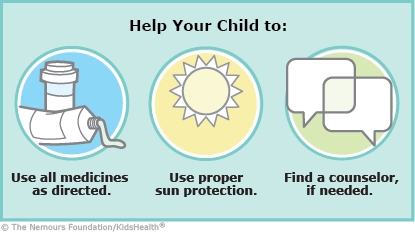Vitiligo is a loss of skin color that causes white patches on the skin. There's no cure for vitiligo (vih-tih-LY-go), but treatments can help even out the skin color. Your child's dermatologist (skin doctor) will help you find the best treatment for your child.
While vitiligo doesn't cause health problems, it can be a big deal to kids and teens because of how the skin patches look. If your child is upset by them, find ways to support them and boost their confidence and self-esteem.


Follow your health care provider's advice for:
Protect the skin from the sun (being out in the sun can make the patches of vitiligo show up more and can increase your child's risk of skin cancer). Your child should:
To help your child cope with vitiligo:

Your child:

What causes vitiligo? Vitiligo happens because skin cells stop making the skin pigment melanin. It's not clear why this happens, but autoimmunity (when the body attacks its own cells, tissues, or organs) may play a role. It can run in families, so there might be a genetic cause. Vitiligo isn't passed from person to person. It happens in people of any skin color but is most noticeable on darker skin.
What are the signs of vitiligo? The white patches can range from small to large and can be in just one area or many. They also might itch. More or bigger patches can develop over time, or they might stay the same. Sometimes the patches go away on their own. Vitiligo can also affect the hair, eyebrows, eyelashes, inside of the mouth and ears, and the retina of the eye.
Does vitiligo make a child more likely to have other medical conditions? Kids with vitiligo are generally healthy. They are a little more likely to have problems with their thyroid (a gland in the neck that has many jobs, such as controlling growth and how the body uses energy). They're not at higher risk for skin cancer.